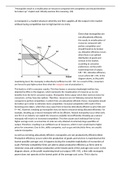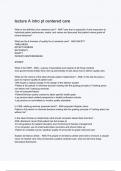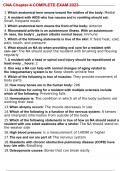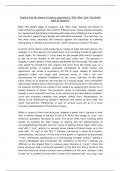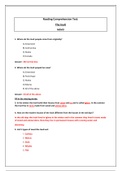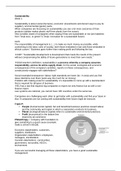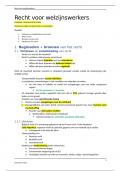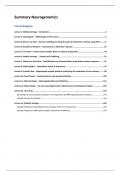Summary Marketing 3: The marketing environment
3.1 Marketing environment
The environment includes consumers, competitors, distributers and other organizations. The
environment is everything that is not part of its own organisation.
The internal environment is also known as the microenvironment. They are essentially controllable.
The internal environment consists of the resources available to implement the strategic plan and the
various functional areas or departments in the company. It also includes the corporate culture.
Organisations have only limited resources to accomplish their objectives. Primary resources are
financial resources, commercial resources, technical resources, natural resources and human
resources.
The external environment involves all of the uncontrollable influences and groups that orginate
outside the organization.
The first step in environmental scanning is to determine the need for information for strategy
development. Environmental scanning is the process of collecting information about the elements of
a company’s environment.
The assessment of available data plays a major role in marketing decision making based on the
environmental diagnosis, an evaluation of the significance of the opportunities and threats disclosed
by the environmental analysis. An environmental analysis is the monitoring and evaluation of the
external environment to determine the source of a company’s opportunities and threats.
3.2 Mesoenvironment
The mesoenvironment is essentially the (branch of) industry or market in which the company
operates. It is the immediate environment in which the marketer and firm interact with customers,
suppliers, intermediaries such as distributers, competitors and public groups or stakeholders.
, The supply chain
Several organisations are involved in
the stages that a product goes
through from production to
consumption. These parties make up
the supply chain: the connected
chain of all of the business entities,
both internal and external to the
company, which perform or support
various functions in the production
process.
Some corporations control all links in
the supply chain such as in the oil
industry.
Each link or “horizontal section” in
the supply chain is known as a
sector.
The supply chain management is to
coordinate and integrate all the
activities of the supply chain
members – from the source to the
point of consumption – into an
efficient process.
Customers
There are four types of customer
markets:
Consumer market: the market for products and services purchased or rented by individuals,
families or households for their own consumption or use.
Industrial market: the market for goods sold to and purchased by businesses for use in their
own production of other goods and services, which they then sell or supply to other
businesses at a profit.
Intermediary market: the marketing consisting of organisations that buy products and resell
them without any further processing, with the objective of making a profit.
Institutional market: the market consisting of large-scale users (such as nursing homes,
schools and hospital cafeterias), government agencies and other non-profit organisations.
In environmental scanning, we collect information about key factors for each of the firm’s active
markets (or the firm might want to enter). Next, we try to identify possible market segments in the
four customer markets (age, size). This is the way to develop an effective marketing strategy to
satisfy the needs and wants of that part of the market.
Suppliers
Supplier marketing is systematically analyzing the suppliers. Buying from several supplier is called is a
strategy called multiple sourcing. Companies use methods to increase profits or gain more control of
supply.
Intermediaries
Intermediaries are companies that operate as a link between producers and consumers or, as
middleman, specialize in providing services of facilitate transaction between suppliers and customers
(wholesalers/retailers/distributer, marketing research agencies and transportation and storage
companies).
3.1 Marketing environment
The environment includes consumers, competitors, distributers and other organizations. The
environment is everything that is not part of its own organisation.
The internal environment is also known as the microenvironment. They are essentially controllable.
The internal environment consists of the resources available to implement the strategic plan and the
various functional areas or departments in the company. It also includes the corporate culture.
Organisations have only limited resources to accomplish their objectives. Primary resources are
financial resources, commercial resources, technical resources, natural resources and human
resources.
The external environment involves all of the uncontrollable influences and groups that orginate
outside the organization.
The first step in environmental scanning is to determine the need for information for strategy
development. Environmental scanning is the process of collecting information about the elements of
a company’s environment.
The assessment of available data plays a major role in marketing decision making based on the
environmental diagnosis, an evaluation of the significance of the opportunities and threats disclosed
by the environmental analysis. An environmental analysis is the monitoring and evaluation of the
external environment to determine the source of a company’s opportunities and threats.
3.2 Mesoenvironment
The mesoenvironment is essentially the (branch of) industry or market in which the company
operates. It is the immediate environment in which the marketer and firm interact with customers,
suppliers, intermediaries such as distributers, competitors and public groups or stakeholders.
, The supply chain
Several organisations are involved in
the stages that a product goes
through from production to
consumption. These parties make up
the supply chain: the connected
chain of all of the business entities,
both internal and external to the
company, which perform or support
various functions in the production
process.
Some corporations control all links in
the supply chain such as in the oil
industry.
Each link or “horizontal section” in
the supply chain is known as a
sector.
The supply chain management is to
coordinate and integrate all the
activities of the supply chain
members – from the source to the
point of consumption – into an
efficient process.
Customers
There are four types of customer
markets:
Consumer market: the market for products and services purchased or rented by individuals,
families or households for their own consumption or use.
Industrial market: the market for goods sold to and purchased by businesses for use in their
own production of other goods and services, which they then sell or supply to other
businesses at a profit.
Intermediary market: the marketing consisting of organisations that buy products and resell
them without any further processing, with the objective of making a profit.
Institutional market: the market consisting of large-scale users (such as nursing homes,
schools and hospital cafeterias), government agencies and other non-profit organisations.
In environmental scanning, we collect information about key factors for each of the firm’s active
markets (or the firm might want to enter). Next, we try to identify possible market segments in the
four customer markets (age, size). This is the way to develop an effective marketing strategy to
satisfy the needs and wants of that part of the market.
Suppliers
Supplier marketing is systematically analyzing the suppliers. Buying from several supplier is called is a
strategy called multiple sourcing. Companies use methods to increase profits or gain more control of
supply.
Intermediaries
Intermediaries are companies that operate as a link between producers and consumers or, as
middleman, specialize in providing services of facilitate transaction between suppliers and customers
(wholesalers/retailers/distributer, marketing research agencies and transportation and storage
companies).

